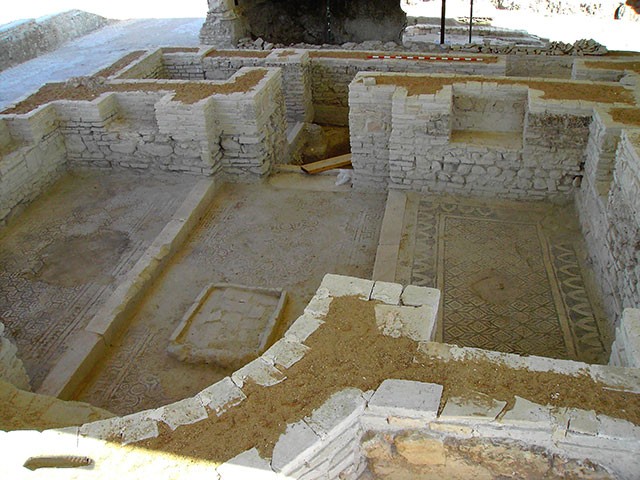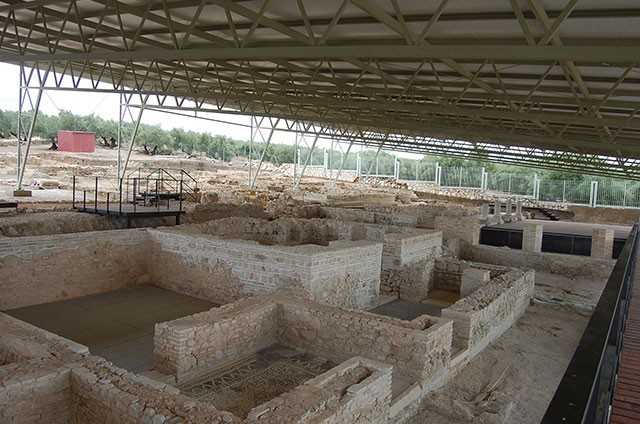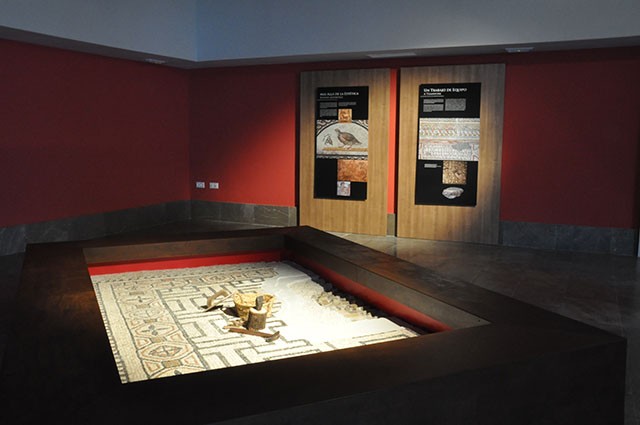Fuente Álamo Roman Villa

The Roman Villa of Fuente Álamo is located approximately 3 km NE of the urban area of Puente Genil, accessed by the road that leads to the village of Los Arenales.
Located next to a stream, the land is currently occupied by olive groves. Fuente Álamo is a Spanish-Roman villa like many others that proliferated in the III-IV centuries AD. in Hispania. It is administratively registered within the Conventus Iuridicus Astigitanus, like the entire middle valley of the Genil.
At first glance, in the site we can find a dissemination of old Roman buildings, arranged more or less in relation to the water source and with an obvious interconnection between them that give us an overview. Remains of different types of Roman construction works throughout the area show us a relatively important settlement nucleus.

Fuente Álamo stands out for its interesting set of museums especially. There are numerous musivary pavements found and even more that are yet to appear, all of which speaks unequivocally about the importance of the settlement, as well as the tastes, purchasing power and social status of the owner of the estate. Fuente Álamo Roman Villa has one of the most important figurative and geometric ensembles in Spain without a doubt. Mosaic is a decorative art used to pave floors or decorate walls, which uses tesserae, small pieces of glass, marble, ceramic or stone to create images or drawings.
The mosaics are an anonymous work in most of the cases. The making of a mosaic was a very laborious job that required a very strict division of tasks and involved a large number of people. Most of these artisans moved from one city to another to carry out the work. Even less is known about their clients. Although we can affirm that the mosaic is an expression of power, a reflection of the social position and fortune of the client.

Romans used mosaics to present the most varied scenes, of nature, daily life, games or the gods. So far in Fuente Álamo, the figurative mosaics represent images linked to the world of the gods. For the Roman people the presence of the divine is constant, every decision in daily life and even every gesture is subject to the gaze of the Gods.
There are three mosaics that stand out in Fuente Álamo, that of the scenes from the life of Dionysus; the one called the Three Graces and the Nilotic Mosaic. Did you know that they are unique specimens in the entire Roman Empire? All them can be seen in the villa itself, being the Nilotic a copy of the original.
Along with the figurative ones, there are geometric mosaics from different eras, styles and compositions in Fuente Álamo, both two coloured and of various colours. Some of them are also in the town Historical Museum.

A thousand years of the history of Andalusia can be found in Fuente Álamo. Romans, Visigoths and Arabs have left a mark that, having been buried for a long time, today begins to see the light. However, the most striking of what can be seen corresponds to a part of the great house that the Romans called a villa and where the lord resided surrounded by all luxury and comforts with his family and trusted personnel.
The large reception room with a square floor plan, topped by a semicircular headboard, stands out. Here the lord would flaunt his power by receiving clients and friends. Then two anterooms or dressing rooms of what could be the bedrooms and a large room for worship that ends in an apse.
On the other side of the stream there are new living areas and next to them the set of private baths where the owner carried out the daily bath circuit. Loved and appreciated by the Romans for both personal hygiene and social enjoyment.
The materials used in the construction of the villa were stone, brick, tile or marble.
Due to the type of building, the materials used, the extension of the remains and the mosaics found, we are faced with a family, a member of a dominant minority, with great economic capacity and social prestige who wanted to enjoy the comfort of the urban homes with the added benefits of country life.



